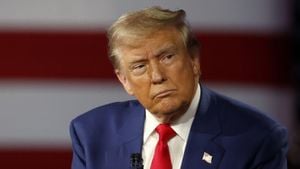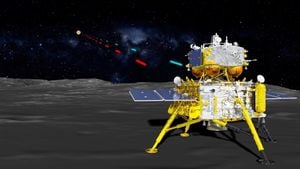Russia is once again flexing its military might and sending shivers down global spines as President Vladimir Putin claims the capabilities of the Oreshnik missile can rival nuclear weapons. This assertion has come during heightened tensions surrounding the Ukraine conflict, with the West offering new military support to Kyiv and Moscow responding with rapid-fire threats and warnings.
The dramatic exchange of artillery, rhetoric, and threats intensified recently. Following more than 1,000 days of conflict, the stakes have escalated significantly. Putin indicated the Oreshnik missile, which is currently undergoing serial production, possesses capabilities so advanced and precise, it could achieve destructive results similar to nuclear arms when utilized massively.
During discussions with military and defense industries, Putin made waves by stating, “The Oreshnik missile system is not just an effective hypersonic weapon. Due to its stunning power, especially when employed en masse alongside other long-range precision systems, using it against enemy targets will have comparable effects to employing strategic nuclear weapons.” The Russian president went on to boldly claim, “No existing defense system could counter the Oreshnik,” adding to the air of dread.
According to the Commander of the Strategic Missile Forces, Sergei Karakayev, successful tests showed the missile is equipped with hypersonic non-nuclear warheads, affirming its ability to hit high-profile military targets. He emphasized its effectiveness against various types of targets, stating, “Mass use of this weapon would be comparable to utilizing nuclear weapons.”
Mixed sentiments have greeted these developments. Vasily Tonkoshkurov, first deputy chair of Russia's military-industry commission, assured audiences the Oreshnik was developed entirely with homegrown technologies and swiftly resolved challenges surrounding import substitutions. This boots-on-the-ground approach taken within Russia’s military machinery raises eyebrows worldwide, making the Oreshnik one to watch closely.
Across the lines, Western nations are not sitting idle. They are ramping up support for Ukraine following unprecedented missile strikes on Russian territory. The United States recently shifted its policy, allowing Ukraine to fire long-range ATACMS missiles at targets within Russia, marking the first time American-made munitions have struck Russian soil during this protracted war. Reports also indicated Ukraine has received Storm Shadow missiles from the UK, which it deployed against Russian forces as well, intensifying hostilities.
The latest barrage was not merely empirical; there was also strategic messaging involved. This week, Putin eroded the threshold for Russia’s nuclear doctrine, equipping the Kremlin with ominous justifications for nuclear deployment should they feel threatened. It was reported Putin’s new doctrine implies attacks from non-nuclear states, backed by nuclear powers like the U.S., represent joint assaults on Russia. That’s not something to dismiss lightly.
Putin’s early October deployment of the Oreshnik missile against targets within Ukraine's Dnipro served as both objective evidence and political theater to signal Russia's willingness to engage more aggressively. The missile, according to Putin, is capable of traveling ten times the speed of sound, making it nearly impossible to intercept. Such claims exacerbate the fears swirling around nuclear escalation, raising eyebrows, and concerns among international observers.
Add to this the continuing negotiations at the international level, and it creates a cocktail of potential conflict. The U.S. and its allies are involved more than ever, cementing their strategic commitment to Ukraine’s defense. Yet, even as the West pledges unfaltering support for Ukraine, observers note the relative ease with which Putin has previously redrawn nuclear boundaries without dire repercussions. The extent of the West's willingness to gamble against Russia's nuclear threats is now being put to the test.
North Korea’s recent voice within this international drama adds another dimension of urgency. Kim Jong Un rebuffed U.S. plans by asserting North Korean troops are prepared to cooperate with Russia against the U.S. and its allies, openly acknowledging the stakes of nuclear conflict as higher than ever before.
So, where does this leave us? Both sides confront munitions and policies indicating readiness to inflict demolition and suffering, putting consistent pressure on the world community to respond to potential escalation. Today’s precarious balance rests on trust, and the efficacy of deterrence strategies among nuclear powers. How nations navigate these treacherous waters could very well define the future stability of international relations and peace.
With the potential alterations to the conflict’s tenor, leaders worldwide need to tread carefully. Any miscalculation could plunge the world back to the dark ages of global conflict—an alarming thought many are struggling with as they monitor the burgeoning tensions between and among these great powers.



